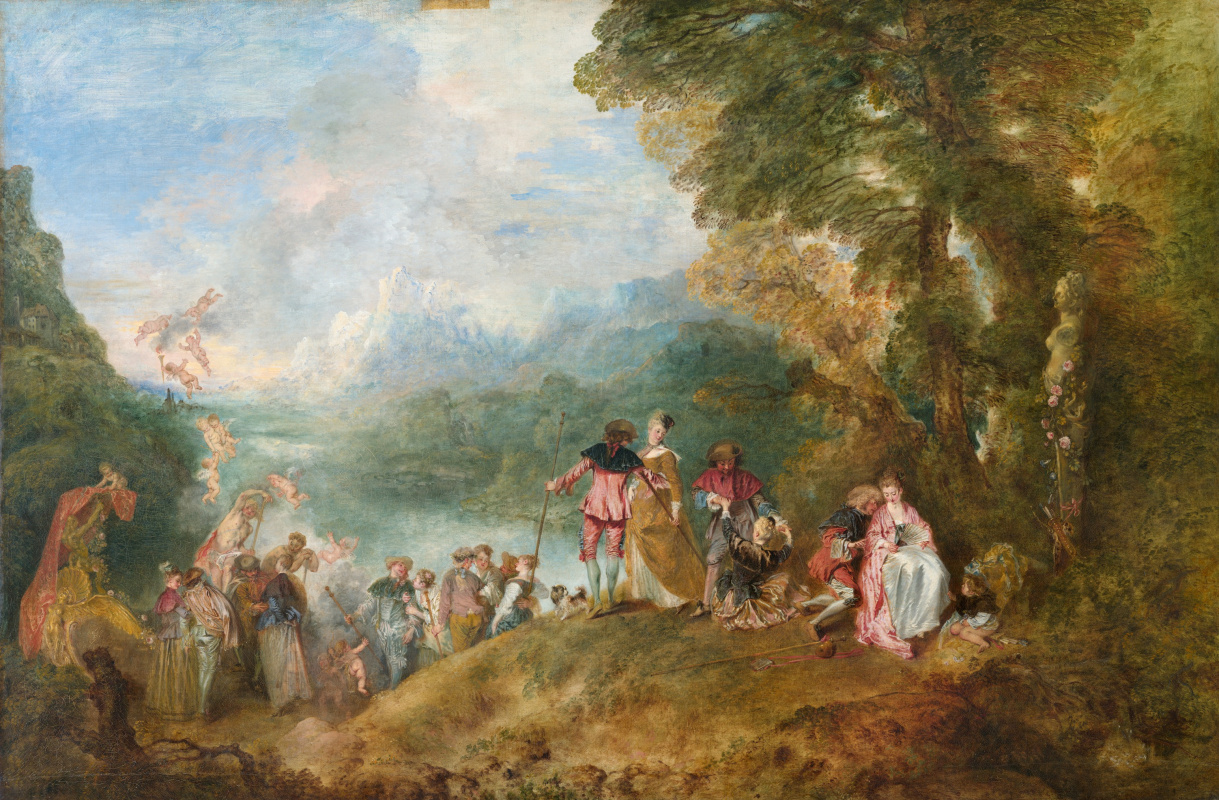log in
Enter site
Login to use Arthive functionality to the maximum
Pilgrimage to the island of Kythira (the first option)
Antoine Watteau • 绘画, 1717, 129×194 厘米
画作描述 «Pilgrimage to the island of Kythira (the first option)»
The plot depicts the allegorical pilgrimage contemporary Antoine Watteau characters on the island of Kythira. Real island, sometimes referred to in Latin — Cetera, located in the Aegean sea South of the Peloponnese and is one of the main cult centers of the goddess of love and beauty, Aphrodite (from the name of the island comes one of the epithets of Aphrodite — "Kyparissia"). It is believed that Watteau put on this mythological underlying cause one of the plot motifs popular in his years of Comedy Florent Dancourt's "the Three cousins", "which mentioned the wonderful island where no girl is returned without a suitor or a husband."
The first option is "Pilgrimage to the island of Kythira" was created by Watteau as a mandatory picture for the ballot to the full members of the Royal Academy of arts. This was preceded by his first attempt entry into the Academy and failure in the contest of 1709 for a scholarship to travel to Rome. The second attempt of entry lasted for 5 years: in 1712, Watteau accept the candidate, but required a picture to enter full members of the Academy, he performs only in 1717. By this time the paintings of Watteau, which he received among his contemporaries called the "gallant scenes", had such a wide success that it gave an opportunity to the members of the Academy not to consider his introductory work in the mandatory system of the classic genres. For Watteau, an exception was made: the painting was given a special status of "gallant celebration", thus the Academy has recognized the merit of the artist. The entry in the minutes of the meeting of the Royal Academy of arts on August 28, 1717, reads: "the Sieur Antoine Watteau, painter, a native of Valenciennes, enumerated 30 Jul 1712, sent the painting, which he was asked to play for his admission to the Academy. It depicts...". Originally it was written: "pilgrimage to the island of Kythira"; then the scribe has crossed out these words, and instead wrote: "gallant festivities".
Creating a second version of this canvas art is dated approx: about 1718. Probably the author's version is unusually large, the artist's works submitted to the meeting of the Academy of arts, ordered from wealthy admirers of Watteau's art.
The first version of "Pilgrimage" subsequently entered the Louvre in composition of the Assembly of the Academy of fine arts and currently occupies a Central place in the works of Watteau. The second author's version in the middle of the XVIII century, was acquired for the art collection of the king of Prussia of Frederick the Great. Now this option to distinguish it received a slightly modified title: "Landing on the island of Kythira", exhibited in Berlin's Charlottenburg Palace.
The first option is "Pilgrimage to the island of Kythira" was created by Watteau as a mandatory picture for the ballot to the full members of the Royal Academy of arts. This was preceded by his first attempt entry into the Academy and failure in the contest of 1709 for a scholarship to travel to Rome. The second attempt of entry lasted for 5 years: in 1712, Watteau accept the candidate, but required a picture to enter full members of the Academy, he performs only in 1717. By this time the paintings of Watteau, which he received among his contemporaries called the "gallant scenes", had such a wide success that it gave an opportunity to the members of the Academy not to consider his introductory work in the mandatory system of the classic genres. For Watteau, an exception was made: the painting was given a special status of "gallant celebration", thus the Academy has recognized the merit of the artist. The entry in the minutes of the meeting of the Royal Academy of arts on August 28, 1717, reads: "the Sieur Antoine Watteau, painter, a native of Valenciennes, enumerated 30 Jul 1712, sent the painting, which he was asked to play for his admission to the Academy. It depicts...". Originally it was written: "pilgrimage to the island of Kythira"; then the scribe has crossed out these words, and instead wrote: "gallant festivities".
Creating a second version of this canvas art is dated approx: about 1718. Probably the author's version is unusually large, the artist's works submitted to the meeting of the Academy of arts, ordered from wealthy admirers of Watteau's art.
The first version of "Pilgrimage" subsequently entered the Louvre in composition of the Assembly of the Academy of fine arts and currently occupies a Central place in the works of Watteau. The second author's version in the middle of the XVIII century, was acquired for the art collection of the king of Prussia of Frederick the Great. Now this option to distinguish it received a slightly modified title: "Landing on the island of Kythira", exhibited in Berlin's Charlottenburg Palace.


